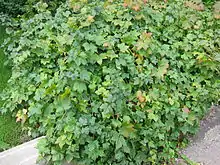Ribes glandulosum
Ribes glandulosum, the skunk currant,[2] is a North American species of flowering plant in the currant family. It is widespread in Canada (all 10 provinces and all 3 territories) and is also found in parts of the United States (Alaska, the Great Lakes region, the Appalachian Mountains, and the Northeast).[3][4]
| Ribes glandulosum | |
|---|---|
 | |
| Scientific classification | |
| Kingdom: | Plantae |
| Clade: | Tracheophytes |
| Clade: | Angiosperms |
| Clade: | Eudicots |
| Order: | Saxifragales |
| Family: | Grossulariaceae |
| Genus: | Ribes |
| Species: | R. glandulosum |
| Binomial name | |
| Ribes glandulosum Grauer 1784 not Ruiz & Pav. 1802[1] | |
Ribes glandulosum is a deciduous shrub growing to 0.5 m (2 ft) tall and wide. It has palmately lobed leaves with 5 or 7 deeply cut segments. Flowers are in elongated clusters of 6–15 pink flowers. Fruits are red and egg-shaped, sometimes palatable but sometimes not.[5][6][2]
Conservation status in the United States
It is listed as endangered in Connecticut and New Jersey, and presumed extirpated in Ohio.[7]
As a noxious weed
It is considered a noxious weed in Michigan, and planting it is prohibited in certain parts of the state.[8]
Ethnobotany
The Ojibwa people take a compound decoction of the root for back pain and for "female weakness".[9] The Woods Cree use a decoction of the stem, either by itself or mixed with wild red raspberry, to prevent clotting after birth, eat the berries as food, and use the stem to make a bitter tea.[10] The Algonquin people use the berries as food.[11]
References
- The International Plant Names Index
- Flora of North America, Ribes glandulosum Grauer, 1784. Skunk currant, gadellier glanduleux
- Biota of North America Program 2014 state-level distribution map
- Biota of North America Program 2014 county distribution map
- United States Department of Agriculture plants profile
- Plants for a Future
- "Plants Profile for Ribes glandulosum (skunk currant)". plants.usda.gov. Retrieved 22 December 2017.
- "Plants Profile for Ribes glandulosum (skunk currant)". plants.usda.gov. Retrieved 22 December 2017.
- Densmore, Frances 1928 Uses of Plants by the Chippewa Indians. SI-BAE Annual Report #44:273–379 (p. 356)
- Leighton, Anna L. 1985 Wild Plant Use by the Woods Cree (Nihithawak) of East-Central Saskatchewan. Ottawa. National Museums of Canada. Mercury Series (p. 54)
- Black, Meredith Jean 1980 Algonquin Ethnobotany: An Interpretation of Aboriginal Adaptation in South Western Quebec. Ottawa. National Museums of Canada. Mercury Series Number 65 (p. 88)
| Wikimedia Commons has media related to Ribes glandulosum. |